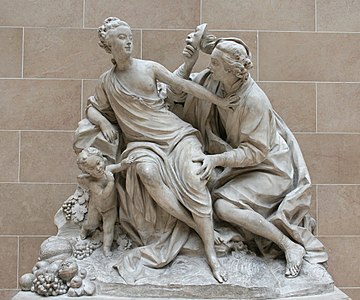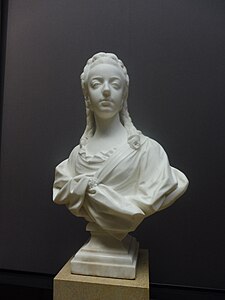Jean-Baptiste Lemoyne
Jean Baptiste Lemoyne | |
|---|---|
 | |
| Born | Jean Baptiste Lemoyne 15 February 1704 Paris, France |
| Died | 25 May 1778 (aged 74) Paris, France |
| Nationality | French |
| Known for | Sculpture |
| Notable work | Fontaine des Quatre-Saisons |
Jean-Baptiste Lemoyne (15 February 1704 – 1778) was a French sculptor of the 18th century who worked in both the rococo and neoclassical style. He made monumental statuary for the Gardens of Versailles but was best known for his expressive portrait busts.[1]
Life[edit]
Jean-Baptiste Lemoyne was born in Paris in 1704. His father Jean-Louis Lemoyne, was also a sculptor, and was first teacher. He later became a student of another prominent sculptor, Robert Le Lorrain.[2] He is sometimes referred to as Jean-Baptiste II Lemoyne or "the younger" to distinguish him from his uncle of the same name, another sculptor, Jean-Baptiste Lemoyne the Elder.[3]
He received the prix de Rome awarded by the Académie royale de peinture et de sculpture, but remained in Paris to aid his blind father. He became a member of the Academy in 1838, and, later became its director. Like the other royal sculptors, made statuary for the Gardens of Versailles. He was a particular favorite of Madame de Pompadour, the mistress of the King and an important patron of the arts. He made a graceful rococo sculpture of Vertumnus and Pomone, two characters from the Metamorphoses of Ovid, which was a favorite theme of Madame Pompadour. The sculpture is now in the Louvre. He also made a state of Madame Pompadour in the costume of a nymph. He made several busts of Louis XV, and an equestrian statue of the King for the courtyard of the new Ecole Militaire, but this was destroyed during the French Revolution.[4]
He was especially known for the quality of his portrait busts, which captured the passing nuances of expression and gave a sense of movement. His important portrait busts included those of the naturalist René Antoine Ferchault de Réaumur (1751); the painter Noël-Nicolas Coypel (1760);[5] the scientist Fontenelle (at Versailles); Madame de Pompadour; and Marie-Antoinette in 1771. He is considered the most skilled of the French rococo sculptors.[6]
Lemoyne's students included Étienne Maurice Falconet Jean-Baptiste Pigalle, and Augustin Pajou.[7]
Sculpture[edit]
-
The Comtesse de Feuquieres by Jean-Baptiste Lemoyne. Terracotta, circa 1738 CE. From Paris, France. The Victoria and Albert Museum, London
-
A plaster bust of his friend Noel-Nicolas Coypel, 1730 (Snite Museum of Art)
-
Louis XV (1749), Palace of Versailles
-
Model for a Monument to Louis XV in Rennes (1746–48), Art Institute of Chicago
-
Vertumnus and Pomona, 1760 (the Louvre)
-
Essaying and scientist Bernard Le Bovier de Fontenelle (1749) Carnegie Museum of Art
-
Geneviève-Françoise Randon de Malboissière (1768), Metropolitan Museum of Art
-
Marie-Antoinette (1771) (Musée d'Histoire de l'art, Vienne)
-
The Duchesse de La Rochefoucauld (1774), Metropolitan Museum of Art
See also[edit]
Notes[edit]
- ^ Le Petit Robert des Noms Propres, (2010)
- ^ Louis Réau, Une dynastie de sculpteurs au XVIIIe siècle : les Lemoyne, 1927.
- ^ Le Petit Robert des Noms Propres, (2010)
- ^ Le Petit Robert des Noms Propres, (2010)
- ^ Le Petit Robert des Noms Propres, (2010)
- ^ Geese, L'Art Baroque – Architecture, sculpture, peinture (2015), pg. 314
- ^ Grasselli, Margaret Morgan (2009). Renaissance to revolution: French drawings from the National Gallery of Art, 1500–1800. Washington, D.C.: National Gallery of Art. p. 224. ISBN 9781848220430.
Bibliography[edit]
- Brocvielle, Vincent (2017). La Petit Larousse de l'Histoire de l'Art (in French). Larousse. ISBN 978-2-03-5936-39-4.
- Jeancolas, Claude (1992). Sculpture Française. Paris: CELIV. ISBN 2-86535-162-9.
- Geese, Uwe, Section on Baroque sculpture in L'Art Baroque – Architecture – Sculpture – Peinture (French translation from German), H.F. Ulmann, Cologne, 2015. (ISBN 978-3-8480-0856-8)
- Duby, Georges and Daval, Jean-Luc, La Sculpture de l'Antiquité au XXe Siècle, (French translation from German), Taschen, (2013), (ISBN 978-3-8365-4483-2)
External links[edit]
 Media related to Jean-Baptiste Lemoyne the Younger at Wikimedia Commons
Media related to Jean-Baptiste Lemoyne the Younger at Wikimedia Commons- Jean-Baptiste Lemoyne in American public collections, on the French Sculpture Census website









